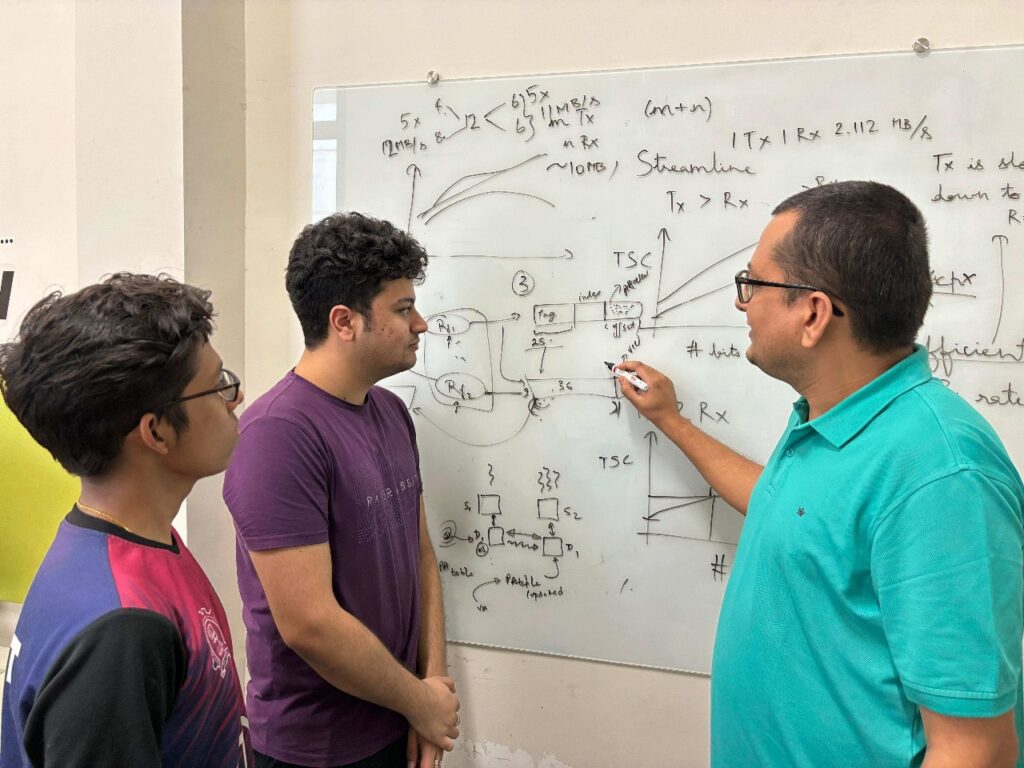Maya Cache: A Desi Odyssey in Secure Cache Design

Research is about knowing or finding out more and more about less and less. So take a problem, and ask the right set of questions with a pause.
Step into the world of Prof. Biswabandan Panda as he shares behind-the-screen details about his paper “The Maya Cache: A Storage-efficient and Secure Fully-associative Last-level Cache,” which was recently accepted at the 51st International Symposium on Computer Architecture (ISCA 2024) – the flagship forum for groundbreaking research in computer architecture.
Authored by his undergraduate students Anubhav Bhatla and Navneet, the paper introduces a high-performing, energy-efficient, and secure randomized cache that renders cross-core conflict-based attacks impossible, boasting a staggering resistance of over 10^16 years.
This marks a significant milestone – the first student-authored paper from the Indian Institute of Technology, Bombay to appear in ISCA, and indeed, a lead student author paper in ISCA from the IITs after a gap of 44 years!
In this interview, Prof. Panda shares insights into the genesis of the Maya Cache, its significance, and the journey to its acceptance. Discover how mentorship, persistence, and a touch of “desi” creativity have led to this remarkable achievement in Indian academia.
This research was funded by the Trust Lab Grant 2023.
Could you please introduce yourself and provide an overview of your research interests?
I am Biswa, a faculty member in the Department of Computer Science Engineering at IIT Bombay. I am primarily interested in computer architecture and its interactions with the computer systems stack for performance and security. I love to delve into the subtle nuances in the field of microarchitecture.
Could you explain the significance of your findings in layman’s terms for those unfamiliar with computer architecture?
Our findings provide ways to design secure processors without paying the price of conflicting trade-offs like performance, storage, and cost overheads.
What inspired the choice of the name “Maya Cache” for your proposed cache design?
The word Maya means an illusion. The Maya cache is an illusion of a fully associative cache to the attacker. However, in reality, it is still a K-way associative cache. We did spend a few days deciding on the title as I always look for a “desi” name .
How do you feel about the acceptance of your paper at ISCA 2024, considering its prestige in the field of computer architecture?
As a mentor, I feel proud and happy as research papers from India at flagship computer architecture forums like ISCA and MICRO are not that regular. So, there is a sense of achievement and accomplishment.
This year how many papers from Indian academia got accepted at ISCA?
As far as I know, only one and that is from our group.
How many years have you spent on this research problem?
I started thinking about this problem in 2020 when I was at IIT Kanpur and I was planning to move to IIT Bombay. It was a bit of a bumpy ride but that is what computer systems research is all about. It is like test match cricket. You hung in there for four days to see the result on day 5. Thanks to Anubhav and Navneet for joining me in this eventful journey. We are still working on it, and hopefully, we will have better insights sooner than later.
Were there any surprising discoveries or unexpected results that emerged during your research?
Oh yes! We were struggling to argue that Maya cache is indeed secure amidst all the win-win trade-offs. We (Anubhav, Navneet, and I) spent months on it and surprised ourselves that it was indeed secure.
In your opinion, what sets this research paper apart from others in the field of computer architecture?
Simple, intuitive, and commonsensical idea.
Can you share the potential real-world applications of the findings presented in the paper?
Maya cache is an attempt to design a secure cache in modern server processors.
Can you elaborate on how the Trust Lab grant support specifically aided in developing and implementing your research project?
I would say, I was lucky to work with Anubhav and Navneet. Both of them were working with me before we got the Trust lab grant. The Trust lab grant took care of financial support and the Trust lab ecosystem helped them in interacting with other students who are working on similar research problems.
What role do you believe mentorship plays in nurturing young researchers and encouraging them to pursue ambitious projects?
In my opinion, mentors should encourage young researchers to dream big, fail big while still having fun, and then persist, persist, and persist on one single idea for days, months, and years. There is a saying “If you hang around the barbershop long enough, sooner or later you’re gonna get a haircut”. Mentees learn from their mentors. So, mentors should make sure they are passionate about top-quality research, solving good research problems, working hard, and striving for excellence. This will encourage students to give their best and more importantly they will get a kick in their journey of finding ideas or insights.
What advice would you give to undergraduate students who aspire to pursue research in computer science or related fields?
Research is about knowing or finding out more and more about less and less. So take a problem, and ask the right set of questions with a pause. If a researcher understands the problem well then s(he) can come up with extremely simple and yet impactful solutions. So, pick an area, take a problem, and understand the problem deeply. Trying too hard does not work. Research takes its own time. So, work hard and at the same time take hard breaks. If you are at IITB then walk by the Powai lake. Finally, have fun with your research. Research is fun because you do not know what is coming, or what is on the way. So, having fun is the key to long-term research.

